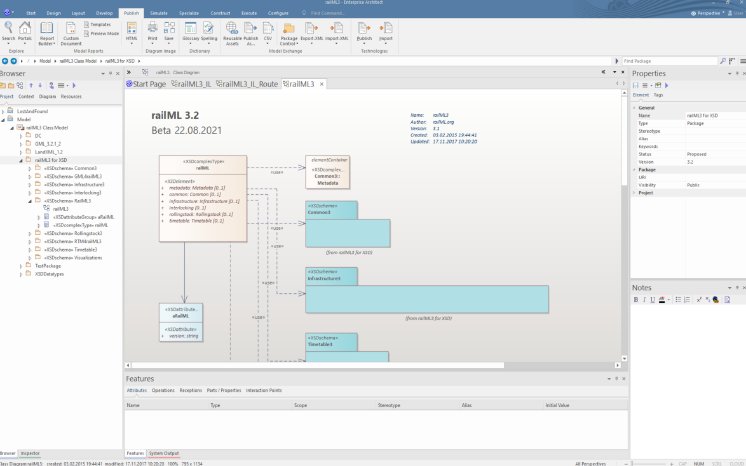railML was jointly developed in 2002 by the Fraunhofer Institute for Transportation and Infrastructure Systems (IVI) in Dresden and the Swiss Federal Institute of Technology Zurich (ETH) and has since been further developed in the railML consortium. For a long time, data exchange in the railway sector was carried out with the help of proprietary and complex interfaces. railML has replaced this process with a uniform interface based on XML and has been using the Enterprise Architect modelling platform from Sparx Systems for about six years. The schemas (XSD files) used in this process are developed, for example, for the infrastructure, for the timetable and vehicles or for the safety technology. Dr.-Ing. Jörg von Lingen, railway specialist and railML.org volunteer: "The railway companies cooperating with us adapt their databases to these schemata so that data exchange functions smoothly. Through UML modelling we achieve a much better data quality and the different needs of the users can be supported more easily."
In March 2022, this preliminary work is to be incorporated into ISO Technical Specification 4398, a special recognition of the work done here. Regardless, railML will continue to be available free of charge to all. Within three years, the Technical Specification will be reviewed and then republished as ISO/IS.
LemonTree: Swiss Army Knife for Models
Since railML requires several working groups to work with the increasingly large UML model, splitting and merging the modified model parts used to be very time-consuming. Therefore, it was now decided to introduce LemonTree in interaction with GitLab for version control. "I would describe LemonTree as a Swiss pocket knife for models. With its help, the working groups can make changes in their part of the model and ultimately everything is merged back into a central UML model with LemonTree. This way we always have a valid EAP file and use the Git repository for version management."
Dr Konrad Wieland, CEO of LieberLieber, comments: "Particularly due to the rapidly progressing climate change, rail is becoming increasingly important as an environmentally friendly means of transport. We are therefore very pleased that LemonTree is helping to simplify the work with models and schemes in the rail sector. Data exchange in such a comprehensive, complex and heterogeneous system as the railway sector is a demanding and costly task. Standardised data exchange also makes it possible to achieve considerable savings for the railway companies involved. At the same time, we would like to congratulate railML very warmly on the fact that the many years of standardisation work are now to be transferred to ISO/TS 4398:2022. We are of course very happy to continue to support the voluntary team with advice and action."
In any case, railML now sees itself well equipped for the future: "The challenge for the future will certainly be to stabilise the work with Enterprise Architect, LemonTree and the Git repository. The requests for additions to the schemas will continue to come from the working groups. And it will then be up to the four coordinators to decide which additions to implement and how." And if the inclusion as an ISO Technical Specification is successful, then many more railway companies will probably join the initiative to better manage data exchange.
Updated development environment for railML
For more than 10 years, the development of the railML 2.x versions and later also the 3.x versions was supported by the "trac ticket" system. Here the coordinators had an overview of upcoming changes and other development tasks. All changes to the versions could then be tracked via the Apache Subversion Repository (SVN for short). In order to make development and progress more accessible to the railML community, the repository and ticket system have now been merged. For this purpose, GitLab was chosen in addition to LemonTree. GitLab is a kind of clone of GitHub, the well-known and widely used open source repository. The new railML 3 repository and ticket system can be viewed publicly at https://development.railml.org/railml .
About railML.org®
railML.org® deals with the standardisation and thus simplification of data exchange in the railway sector. The project lives from the cooperation of the users of the standard. Therefore, everyone interested is invited to participate in the development and to contribute their own needs and experiences to future railML® sub-schemas. The overall initiative is supported and coordinated by a voluntary committee, which conducts the business of railML.org® between the bi-annual conferences.
More information can be found at www.railml.org





